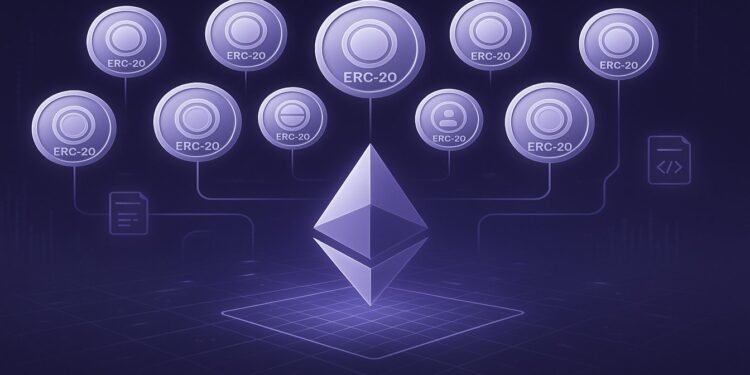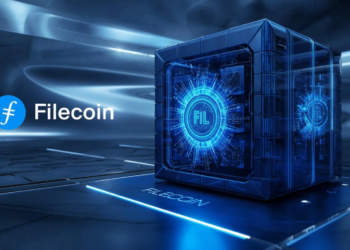If you’ve spent any time in the world of Ethereum or decentralized finance (DeFi), chances are you’ve come across the term ERC-20. But what exactly is it, and why is it such a big deal in the blockchain ecosystem?
In this guide, we’ll break down what ERC-20 tokens are, how they work, and why they’ve become the foundation of thousands of crypto projects. Whether you’re a beginner or brushing up on Ethereum fundamentals, this article will help you get a solid understanding of ERC-20 tokens.
What Are ERC-20 Tokens?
ERC-20 stands for Ethereum Request for Comment 20, a technical standard used for creating fungible tokens on the Ethereum blockchain. Fungible means each token is exactly the same as every other token — just like how each dollar bill is worth the same as another.
ERC-20 defines a common set of rules that Ethereum tokens must follow, including how they can be transferred, how transactions are approved, and how users can access data about a token.
Think of it as a blueprint that allows developers to build tokens that can easily interact with Ethereum wallets, dApps, and smart contracts.
Why Is ERC-20 Important?
Before the ERC-20 standard was introduced in 2015, each Ethereum-based token had its own unique implementation. This made it difficult for wallets, exchanges, and applications to support them without custom integrations.
ERC-20 brought consistency. With one common framework, it became easier to create, deploy, and interact with tokens — sparking the growth of thousands of projects like Uniswap (UNI), Chainlink (LINK), and USDT (Tether).
In short, ERC-20 made Ethereum programmable, scalable, and compatible.
Key Features of ERC-20 Tokens
ERC-20 tokens share a core set of functions that make them easy to interact with:
totalSupply: Returns the total number of tokens in circulation.balanceOf: Shows how many tokens a user owns.transfer: Sends tokens from the sender to another address.approve: Authorizes another account to spend tokens on your behalf.transferFrom: Moves tokens based on an earlierapprovecommand.allowance: Checks how many tokens a spender is allowed to use.
These functions allow ERC-20 tokens to behave predictably across different platforms, making them interoperable and secure.
Real-World Use Cases
The ERC-20 standard paved the way for a wide range of innovations in the crypto space:
- Stablecoins like USDC and DAI are built on ERC-20 to provide price-stable digital assets.
- DeFi protocols use ERC-20 tokens for lending, borrowing, staking, and liquidity pooling.
- ICOs (Initial Coin Offerings) and token sales often issue ERC-20 tokens as a way to raise funds.
- Utility tokens give access to specific services within a dApp or ecosystem.
Even many NFT marketplaces and DAOs rely on ERC-20 for governance and utility purposes.
How Do You Store or Use ERC-20 Tokens?
To store ERC-20 tokens, you’ll need an Ethereum-compatible wallet, such as:
- MetaMask
- Trust Wallet
- Ledger (hardware wallet)
- Coinbase Wallet
Once in your wallet, you can use ERC-20 tokens in a variety of ways — from swapping on decentralized exchanges (DEXs) like Uniswap, to staking in DeFi protocols, or even voting in DAO proposals.
Just remember: interacting with Ethereum-based tokens usually requires ETH to pay gas fees.
Step-by-Step Guide to Creating an ERC-20 Token
1. Set Up Your Development Environment
You’ll need:
- Node.js and npm installed
- Hardhat or Truffle (popular Ethereum development frameworks)
- MetaMask wallet
- Some ETH (on testnet or mainnet) for gas fees
2. Write the ERC-20 Smart Contract
Here’s a basic example using Solidity:
// SPDX-License-Identifier: MIT
pragma solidity ^0.8.0;
import "@openzeppelin/contracts/token/ERC20/ERC20.sol";
contract MyToken is ERC20 {
constructor(uint256 initialSupply) ERC20("MyToken", "MTK") {
_mint(msg.sender, initialSupply * (10 ** decimals()));
}
}
This contract:
- Imports the ERC-20 standard from OpenZeppelin
- Sets the token name and symbol
- Mints the initial supply to the deployer’s address
3. Compile and Deploy the Contract
Using Hardhat or Truffle:
- Compile the contract
- Connect to a testnet (like Rinkeby or Sepolia)
- Deploy using your wallet
Example Hardhat deployment script:
const hre = require("hardhat");
async function main() {
const MyToken = await hre.ethers.getContractFactory("MyToken");
const token = await MyToken.deploy(1000000); // 1 million tokens
await token.deployed();
console.log("Token deployed to:", token.address);
}
main().catch((error) => {
console.error(error);
process.exitCode = 1;
});
4. Verify and Interact
Once deployed:
- Verify the contract on Etherscan
- Add the token to MetaMask using the contract address
- Interact with it via Web3 tools or DApps
Best Practices
- Use OpenZeppelin libraries for security and standard compliance.
- Test thoroughly on testnets before deploying to mainnet.
- Consider adding features like pausing, minting, or burning if needed.
Core ERC Token Standards
ERC-20 – Fungible Token Standard
- The most widely used standard for fungible tokens (e.g., USDT, LINK).
- Defines how tokens can be transferred and how to keep track of balances.
ERC-721 – Non-Fungible Token (NFT) Standard
- Used for unique, indivisible assets like digital art and collectibles (e.g., CryptoKitties).
ERC-1155 – Multi-Token Standard
- Supports both fungible and non-fungible tokens in a single contract.
- More efficient than ERC-20 and ERC-721 for batch transfers and gaming applications.
Advanced and Specialized Standards
ERC-777 – Advanced Token Standard
- Improves on ERC-20 with features like hooks and operator-based transfers.
- Allows more complex interactions between contracts and tokens.
ERC-4626 – Tokenized Vault Standard
- Standardizes yield-bearing vaults (used in DeFi protocols).
- Makes it easier to integrate vaults across platforms.
ERC-1363 – Payable Token Standard
- Allows tokens to be used as a payment method directly in smart contracts.
- Useful for e-commerce and subscription models.
ERC-2612 – Permit Functionality for ERC-20
- Adds gasless approvals using signatures (used in Uniswap and Aave).
- Improves UX by reducing the need for multiple transactions.
Utility and Infrastructure Standards
ERC-165 – Standard Interface Detection
- Allows contracts to declare which interfaces they implement.
- Essential for interoperability.
ERC-1820 – Universal Registry Standard
- A global registry for interface implementations.
- Works with ERC-777 and other advanced standards.
While ERC-20 tokens are widely adopted, they aren’t without risks:
- Scams and Rug Pulls: Anyone can create an ERC-20 token, so always DYOR (Do Your Own Research).
- High Gas Fees: Ethereum network congestion can make transactions expensive.
- Smart Contract Bugs: If the contract isn’t audited, it may have vulnerabilities.
- Loss of Access: Sending tokens to the wrong address (especially a non-ERC-20 address) can result in permanent loss.
Use verified wallets and platforms, and always double-check the contract address before interacting.
Final Thoughts
ERC-20 tokens have revolutionized how assets are created and managed on Ethereum. They’re the building blocks of DeFi, NFTs, DAOs, and many other blockchain innovations.
Whether you’re a developer, investor, or just crypto-curious, understanding ERC-20 is essential to navigating the Ethereum ecosystem.
As blockchain technology continues to evolve, ERC-20 remains a key piece of the puzzle — empowering users and developers to create value in entirely new ways.
Join Us : Twitter | Website | GitHub | Telegram | Facebook | YouTube

























